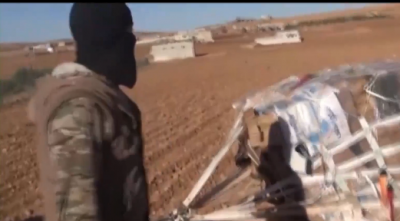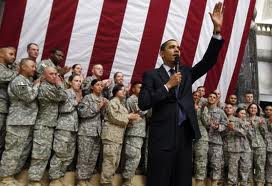Haqqani Leaders Detained in Persian Gulf, Not Inside Afghanistan
Detentions of Anas Haqqani and Hafiz Rashid Inside Afghanistan Had Indicated Possible Shift in Attitude
KABUL—Two recently captured top members of Afghanistan’s Haqqani
network insurgent group were detained in the Persian Gulf and not in
Afghanistan, as Kabul had claimed, Taliban and foreign officials said,
indicating a possible shift in attitude in a region where Afghan
militants have long enjoyed freedom of movement.
The detention of Anas Haqqani, the brother of the Taliban-affiliated group’s chief, and Hafiz Rashid, a military commander, was touted as an important victory for the Afghan government.
 ENLARGE
ENLARGE
 ENLARGE
The Haqqanis, while acknowledging the Taliban leadership’s
authority, operate independently. Unlike the mainstream Afghan Taliban
movement, the Haqqani network is considered a terrorist organization by
the U.S.
ENLARGE
The Haqqanis, while acknowledging the Taliban leadership’s
authority, operate independently. Unlike the mainstream Afghan Taliban
movement, the Haqqani network is considered a terrorist organization by
the U.S.
The Haqqani network was behind many of the most spectacular attacks against foreign and Afghan targets in recent years. Mr. Haqqani and Mr. Rashid are now the most senior members of the network in Afghan custody.
When Afghanistan’s intelligence agency announced their arrest, it said they were detained during an operation in the eastern Afghan province of Khost, the group’s traditional power base. New information indicates the two were picked up in a Gulf country and later taken to Afghanistan.
The Taliban said on Saturday that Mr. Haqqani and Mr. Rashid were arrested on Oct. 12 in Bahrain by U.S. forces, and taken to Qatar and the United Arab Emirates before reaching Kabul.
Several Western officials said the arrests took place in the Gulf, but they were unaware of U.S. involvement.
A senior Afghan security official confirmed the two men were arrested abroad but declined to say in which country. He said the operation was led by Afghanistan’s intelligence service, the National Directorate of Security, and that U.S. forces played no role. A U.S. Embassy spokeswoman in Kabul welcomed the arrests.
“These dangerous men are off the battlefield. We designated the Haqqani Network a Foreign Terrorist Organization in 2012. It’s a lethal network that poses a significant threat to the United States, Afghanistan, Pakistan, and our other partners and allies,,” said the spokeswoman.
It is unclear what role, if any, authorities in Qatar, Bahrain or the U.A.E. played to facilitate the arrests. Officials from the three Gulf states didn't respond to requests for comment on Sunday.
Members of the Afghan Taliban, including the Haqqanis, have long moved relatively freely in Qatar, which in the past has mediated between the U.S. and the militant group. The arrest of the two Haqqani leaders last week, however, may indicate that is changing.
“If they were important and that’s why they were arrested, it would mark a turning point for the Haqqanis and their ability to travel—and perhaps indicate a further erosion of their support and backing,” said Anand Gopal, an author and Taliban expert.
With better resources than other Taliban factions, the Haqqani network has long represented one of the biggest threats to U.S. and allied interests in Afghanistan. U.S. and Afghan officials have alleged the group was behind some of the most spectacular assaults in Afghanistan in recent years, including a 2011 attack on the U.S. Embassy in Kabul that killed 16 people, and another that year on the city’s Intercontinental Hotel that left more than 20 dead.
U.S. and Afghan officials have said Pakistan’s Inter-Services Intelligence agency covertly backed the Haqqanis to extend its influence in Afghanistan, an accusation Islamabad has repeatedly rejected.
While they still represent a formidable threat for foreigners and Afghans, the Haqqanis appear weaker now than they did in the recent past, partly due to the targeting of their leadership and to advances by Afghan security forces in their territory. “They are a shell of their former selves,” Mr. Gopal said.
Anas Haqqani, the youngest son of Jalaluddin Haqqani, the movement’s founder, rose through the ranks of the group after two of his brothers were killed, and was the second-in-command after his brother Sirajuddin Haqqani at the time of his arrest, according to Afghan officials. The officials said Anas Haqqani was in charge of fundraising for the network, which is partly financed by private donations from the Gulf. The Taliban disputed this description of the younger Haqqani, saying he played no formal role in the organization, and that he was a final-year student of religious studies.
They said that before their arrest the two men had traveled to Qatar to visit Mr. Rashid’s brother, Mohammad Nabi Umari. Mr. Umari was one of five Taliban prisoners the U.S. released from Guantanamo Bay prison in May in exchange for U.S. Army Sgt. Bowe Bergdahl, whom the Haqqanis held captive for five years. As part of the prisoner swap, the so-called Guantanamo Five now live in Qatar.
The Taliban said the arrests of Messrs. Haqqani and Rashid were a violation of the terms of that agreement.
“Both men were handed over to Kabul despite the freed Guantanamo detainees being assured that their relatives may visit them unharmed,” the Taliban said. “The American and Kabul administrations aren’t bound by any international law when it suits their political objectives and neither are they truthful in their calls of peace and reconciliation.”
Last year, the Taliban opened a political office in Qatar to host peace talks with the U.S. and Afghan governments. While the office was shut down days after it opened as it got bogged down in controversy, many former Taliban officials still live in the Gulf state.
—Asa Fitch in Beirut contributed to this article.
Write to Margherita Stancati at margherita.stancati@wsj.com
The detention of Anas Haqqani, the brother of the Taliban-affiliated group’s chief, and Hafiz Rashid, a military commander, was touted as an important victory for the Afghan government.
 ENLARGE
ENLARGE
Anas Haqqani, the second-in-command of the Haqqani network, is pictured in detention on Oct. 15.
NDS/Agence France-Presse/Getty Images
 ENLARGE
ENLARGE
Hafiz Rashid, the military commander of the Haqqani network in eastern Afghanistan, on Oct. 15.
NDS/Agence France-Presse/Getty Images
The Haqqani network was behind many of the most spectacular attacks against foreign and Afghan targets in recent years. Mr. Haqqani and Mr. Rashid are now the most senior members of the network in Afghan custody.
When Afghanistan’s intelligence agency announced their arrest, it said they were detained during an operation in the eastern Afghan province of Khost, the group’s traditional power base. New information indicates the two were picked up in a Gulf country and later taken to Afghanistan.
The Taliban said on Saturday that Mr. Haqqani and Mr. Rashid were arrested on Oct. 12 in Bahrain by U.S. forces, and taken to Qatar and the United Arab Emirates before reaching Kabul.
Several Western officials said the arrests took place in the Gulf, but they were unaware of U.S. involvement.
A senior Afghan security official confirmed the two men were arrested abroad but declined to say in which country. He said the operation was led by Afghanistan’s intelligence service, the National Directorate of Security, and that U.S. forces played no role. A U.S. Embassy spokeswoman in Kabul welcomed the arrests.
“These dangerous men are off the battlefield. We designated the Haqqani Network a Foreign Terrorist Organization in 2012. It’s a lethal network that poses a significant threat to the United States, Afghanistan, Pakistan, and our other partners and allies,,” said the spokeswoman.
It is unclear what role, if any, authorities in Qatar, Bahrain or the U.A.E. played to facilitate the arrests. Officials from the three Gulf states didn't respond to requests for comment on Sunday.
Members of the Afghan Taliban, including the Haqqanis, have long moved relatively freely in Qatar, which in the past has mediated between the U.S. and the militant group. The arrest of the two Haqqani leaders last week, however, may indicate that is changing.
“If they were important and that’s why they were arrested, it would mark a turning point for the Haqqanis and their ability to travel—and perhaps indicate a further erosion of their support and backing,” said Anand Gopal, an author and Taliban expert.
With better resources than other Taliban factions, the Haqqani network has long represented one of the biggest threats to U.S. and allied interests in Afghanistan. U.S. and Afghan officials have alleged the group was behind some of the most spectacular assaults in Afghanistan in recent years, including a 2011 attack on the U.S. Embassy in Kabul that killed 16 people, and another that year on the city’s Intercontinental Hotel that left more than 20 dead.
U.S. and Afghan officials have said Pakistan’s Inter-Services Intelligence agency covertly backed the Haqqanis to extend its influence in Afghanistan, an accusation Islamabad has repeatedly rejected.
While they still represent a formidable threat for foreigners and Afghans, the Haqqanis appear weaker now than they did in the recent past, partly due to the targeting of their leadership and to advances by Afghan security forces in their territory. “They are a shell of their former selves,” Mr. Gopal said.
Anas Haqqani, the youngest son of Jalaluddin Haqqani, the movement’s founder, rose through the ranks of the group after two of his brothers were killed, and was the second-in-command after his brother Sirajuddin Haqqani at the time of his arrest, according to Afghan officials. The officials said Anas Haqqani was in charge of fundraising for the network, which is partly financed by private donations from the Gulf. The Taliban disputed this description of the younger Haqqani, saying he played no formal role in the organization, and that he was a final-year student of religious studies.
They said that before their arrest the two men had traveled to Qatar to visit Mr. Rashid’s brother, Mohammad Nabi Umari. Mr. Umari was one of five Taliban prisoners the U.S. released from Guantanamo Bay prison in May in exchange for U.S. Army Sgt. Bowe Bergdahl, whom the Haqqanis held captive for five years. As part of the prisoner swap, the so-called Guantanamo Five now live in Qatar.
The Taliban said the arrests of Messrs. Haqqani and Rashid were a violation of the terms of that agreement.
“Both men were handed over to Kabul despite the freed Guantanamo detainees being assured that their relatives may visit them unharmed,” the Taliban said. “The American and Kabul administrations aren’t bound by any international law when it suits their political objectives and neither are they truthful in their calls of peace and reconciliation.”
Last year, the Taliban opened a political office in Qatar to host peace talks with the U.S. and Afghan governments. While the office was shut down days after it opened as it got bogged down in controversy, many former Taliban officials still live in the Gulf state.
—Asa Fitch in Beirut contributed to this article.
Write to Margherita Stancati at margherita.stancati@wsj.com













